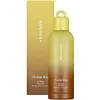What's inside
What's inside
 Key Ingredients
Key Ingredients

 Benefits
Benefits

 Ingredients Side-by-side
Ingredients Side-by-side

Water
Skin ConditioningGlycerin
HumectantPanthenol
Skin Conditioning1,2-Hexanediol
Skin ConditioningCamellia Sinensis Leaf Extract
AntimicrobialMethyl Gluceth-20
HumectantGanoderma Lucidum Stem Extract
Skin ConditioningInonotus Obliquus Extract
Skin ConditioningPhellinus Linteus Extract
Skin ConditioningHydroxyacetophenone
AntioxidantArginine
MaskingBeta-Glucan
Skin ConditioningTheobroma Cacao Extract
Skin ConditioningButylene Glycol
HumectantCentella Asiatica Extract
CleansingAsiaticoside
AntioxidantMadecassoside
AntioxidantAsiatic Acid
Skin ConditioningMadecassic Acid
Skin ConditioningAvena Sativa Meal Extract
SoothingCarbomer
Emulsion StabilisingDisodium EDTA
Citric Acid
BufferingDextrin
AbsorbentWater, Glycerin, Panthenol, 1,2-Hexanediol, Camellia Sinensis Leaf Extract, Methyl Gluceth-20, Ganoderma Lucidum Stem Extract, Inonotus Obliquus Extract, Phellinus Linteus Extract, Hydroxyacetophenone, Arginine, Beta-Glucan, Theobroma Cacao Extract, Butylene Glycol, Centella Asiatica Extract, Asiaticoside, Madecassoside, Asiatic Acid, Madecassic Acid, Avena Sativa Meal Extract, Carbomer, Disodium EDTA, Citric Acid, Dextrin
Botrytis Cinerea/Passiflora Edulis Fruit Extract/Piceatannol Ferment Lysate Filtrate
Water
Skin ConditioningButylene Glycol
HumectantGlycerin
HumectantPanthenol
Skin Conditioning1,2-Hexanediol
Skin ConditioningChondrus Crispus Extract
Skin ConditioningGlyceryl Acrylate/Acrylic Acid Copolymer
HumectantHydroxyethylcellulose
Emulsion StabilisingAdenosine
Skin ConditioningDipropylene Glycol
HumectantPvm/Ma Copolymer
Emulsion StabilisingPantolactone
HumectantSodium Hyaluronate
HumectantEthylhexylglycerin
Skin ConditioningDisodium EDTA
Botrytis Cinerea/Passiflora Edulis Fruit Extract/Piceatannol Ferment Lysate Filtrate, Water, Butylene Glycol, Glycerin, Panthenol, 1,2-Hexanediol, Chondrus Crispus Extract, Glyceryl Acrylate/Acrylic Acid Copolymer, Hydroxyethylcellulose, Adenosine, Dipropylene Glycol, Pvm/Ma Copolymer, Pantolactone, Sodium Hyaluronate, Ethylhexylglycerin, Disodium EDTA
 Reviews
Reviews

Ingredients Explained
These ingredients are found in both products.
Ingredients higher up in an ingredient list are typically present in a larger amount.
1,2-Hexanediol is a synthetic liquid and another multi-functional powerhouse.
It is a:
- Humectant, drawing moisture into the skin
- Emollient, helping to soften skin
- Solvent, dispersing and stabilizing formulas
- Preservative booster, enhancing the antimicrobial activity of other preservatives
Butylene Glycol (or BG) is used within cosmetic products for a few different reasons:
Overall, Butylene Glycol is a safe and well-rounded ingredient that works well with other ingredients.
Though this ingredient works well with most skin types, some people with sensitive skin may experience a reaction such as allergic rashes, closed comedones, or itchiness.
Learn more about Butylene GlycolDisodium EDTA plays a role in making products more stable by aiding other preservatives.
It is a chelating agent, meaning it neutralizes metal ions that may be found in a product.
Disodium EDTA is a salt of edetic acid and is found to be safe in cosmetic ingredients.
Learn more about Disodium EDTAGlycerin is already naturally found in your skin. It helps moisturize and protect your skin.
A study from 2016 found glycerin to be more effective as a humectant than AHAs and hyaluronic acid.
As a humectant, it helps the skin stay hydrated by pulling moisture to your skin. The low molecular weight of glycerin allows it to pull moisture into the deeper layers of your skin.
Hydrated skin improves your skin barrier; Your skin barrier helps protect against irritants and bacteria.
Glycerin has also been found to have antimicrobial and antiviral properties. Due to these properties, glycerin is often used in wound and burn treatments.
In cosmetics, glycerin is usually derived from plants such as soybean or palm. However, it can also be sourced from animals, such as tallow or animal fat.
This ingredient is organic, colorless, odorless, and non-toxic.
Glycerin is the name for this ingredient in American English. British English uses Glycerol/Glycerine.
Learn more about GlycerinPanthenol is a common ingredient that helps hydrate and soothe the skin. It is found naturally in our skin and hair.
There are two forms of panthenol: D and L.
D-panthenol is also known as dexpanthenol. Most cosmetics use dexpanthenol or a mixture of D and L-panthenol.
Panthenol is famous due to its ability to go deeper into the skin's layers. Using this ingredient has numerous pros (and no cons):
Like hyaluronic acid, panthenol is a humectant. Humectants are able to bind and hold large amounts of water to keep skin hydrated.
This ingredient works well for wound healing. It works by increasing tissue in the wound and helps close open wounds.
Once oxidized, panthenol converts to pantothenic acid. Panthothenic acid is found in all living cells.
This ingredient is also referred to as pro-vitamin B5.
Learn more about PanthenolWater. It's the most common cosmetic ingredient of all. You'll usually see it at the top of ingredient lists, meaning that it makes up the largest part of the product.
So why is it so popular? Water most often acts as a solvent - this means that it helps dissolve other ingredients into the formulation.
You'll also recognize water as that liquid we all need to stay alive. If you see this, drink a glass of water. Stay hydrated!
Learn more about Water